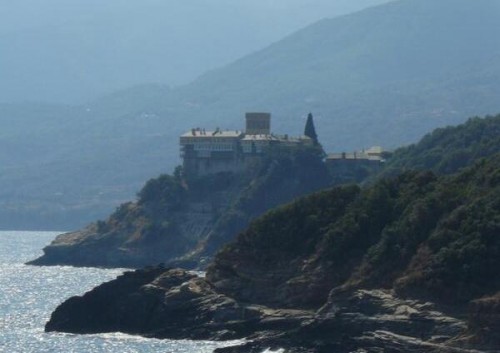Wanderings on Athos, the Holy Mountain
28 Οκτωβρίου 2013
September 17, 2013
When I was 19 I tried for the first time to gain a permit to enter the Holy Mountain. I am an Anglican and a believer, and have long been interested in monasticism and Orthodox spirituality. In 1987, my application was unsuccessful and I rather lost heart; I have waited over 25 years to fill the gap in my Greek cv.
Last week, after finally securing the necessary permissions (without difficulty – thanks to the Church authorities), I travelled north, alone except for my security, to spend three nights on Athos. I was determined to visit as a pilgrim, with as little protocol as possible. For me the serious pilgrim takes to his feet and measures the spiritual experience in real time, far from the car and the clock. Now that most travel on Athos by vehicle, I was fortunate that one of my Greek security team was willing to tolerate an English eccentric and accompany me on foot.
In the event, my tireless security-man and I walked many miles, sometimes inland, sometimes on the shoreline, sometimes in the forest. The natural beauty of Athos is staggering. Not just the glittering light on the ocean’s surface and the domineering crag of Athos itself, but also the dappled shade of the deciduous forest and the indented bays and inlets of the shoreline. In that place a lyrical romantic feels close enough to the Sublime, whatever his faith and hopes.
But for me, the primacy of experience on Athos is not the natural beauty of the virgin landscape, but the immersion of the believer in the patterns and demands of the religious life. We visited five northerly monasteries and stayed at three. In all, we were given hospitality, friendship and conversation, and were quietly encouraged to join the community at prayer. This, especially for a non-Orthodox, is where the privilege of the permission lies.
I love the Orthodox liturgy and have attended many beautiful celebrations of it. But at Iviron, Stavronikita and Xenophontos, it seemed to me, for the first time, to give access to the deepest spiritual truths and to expose the soul to its deepest questioning. At the Divine Liturgy in Iviron and at Evensong in Xenophontos, I was embarrassed by the tears on my cheeks. But, on looking around me, I realised I was not alone. Most of us were visibly moved by the beautiful harmony of music, architecture and art, and by the liturgy’s dense verbal imagery and its clear insistence on the path of penitence and mercy. Not just an experience to treasure, but one I hope to repeat in the years ahead of me here in Greece.
********************************************
On a more secular level, I have been thinking a lot recently about the naval ties between Britain and Greece. I had the honour of visiting the Response Force Task Group Cougar 13, when it was in port two weeks ago at Souda Bay on Crete. On board the flagship HMS BULWARK we were honoured by the presence of the Chief of the Greek Navy, Vice-admiral Apostolakis.
The ties between our navies are real, of long standing and abiding. Our First Sea Lord, Admiral Zambellas is himself of Greek descent. And, in addition to defence co-operation, we share many interests in the merchant marine. Last week was International Maritime Shipping Week in London. The Minister of the Merchant Marine, Mr Varvitsiotis, attended and gave an address at one of the principal events hosted by British Shipping Minister, Mr Hammond. I shall say more about these enduring links in my next blog. In the meantime, enjoy what remains of the summer!
http://blogs.fco.gov.uk/greekblogyssey/2013/09/17/wanderings-on-athos-the-holy-mountain/




